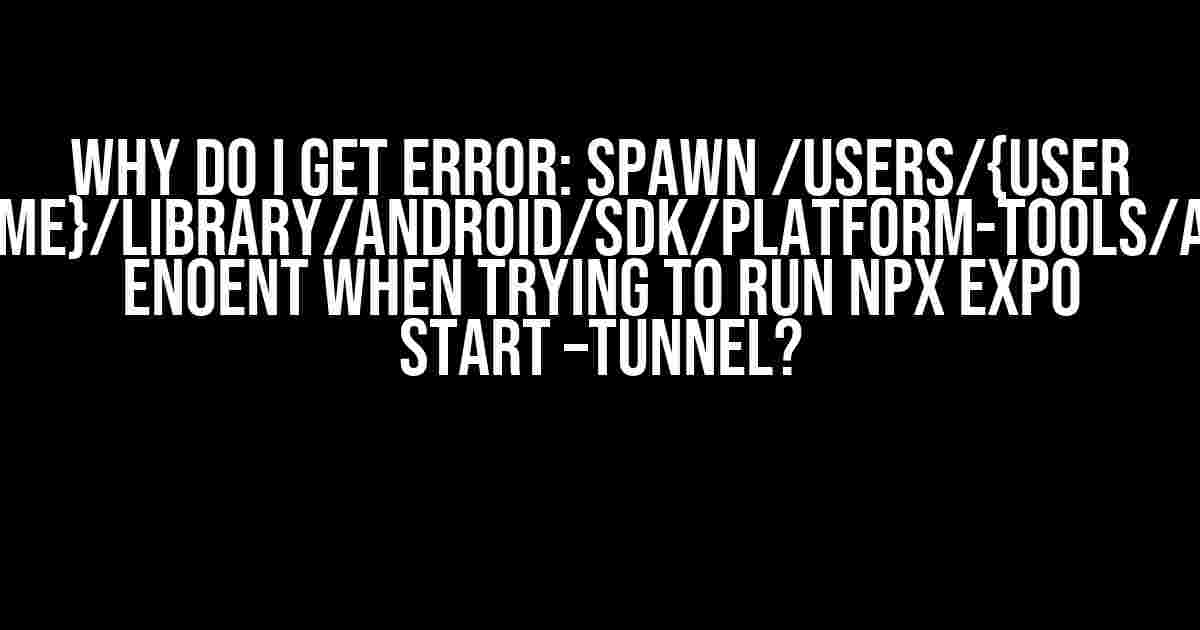Are you tired of getting that annoying error message when trying to run `npx expo start –tunnel`? You’re not alone! Many developers have faced this frustrating issue, but don’t worry, we’re here to help you troubleshoot and fix it once and for all!
What is ENOENT Error?
The ENOENT error stands for “Error No Entity” or “File or Directory Not Found.” It occurs when your system can’t find the specified file or directory. In this case, it’s specifically related to the Android Debug Bridge (ADB) tool.
Why does this error occur?
There are a few reasons why you might be getting this error. Here are some possible causes:
- ADB not installed or configured correctly: Make sure you have the Android SDK installed and the ADB tool is in your system’s PATH.
- ADB location changed: If you’ve recently updated your Android SDK or changed the location of the platform-tools folder, this might cause the error.
- Permission issues: Your system might be restricting access to the ADB tool due to permission issues.
- Corrupted ADB installation: Sometimes, the ADB installation can get corrupted, leading to this error.
Troubleshooting Steps
Let’s dive into the troubleshooting steps to resolve this error. Follow these steps carefully to get your `npx expo start –tunnel` command working again!
Step 1: Check ADB installation and configuration
Make sure you have the Android SDK installed and the ADB tool is in your system’s PATH. Here’s how to do it:
adb --version
If you don’t have ADB installed, download the Android SDK from the official website and follow the installation instructions.
Step 2: Verify ADB location
Check if the ADB tool is located in the correct directory. Open your terminal and run:
which adb
This should output the path to the ADB executable. If it’s not in the correct location, you can update your system’s PATH variable to include the correct directory.
Step 3: Update PATH variable (if necessary)
If you need to update your PATH variable, follow these steps:
For Mac/Linux users:
export PATH=$PATH:/Users/{user name}/Library/Android/sdk/platform-tools/
For Windows users:
set PATH=%PATH%;C:\Users\{user name}\AppData\Local\Android\Sdk\platform-tools\
Step 4: Check permissions
Ensure that the ADB tool has the correct permissions. Try running the following command:
sudo chown -R $USER ~/.android/ ~/.android/adb*
This sets the ownership of the `.android` directory and its contents to the current user.
Step 5: Reinstall ADB (if necessary)
If none of the above steps resolve the issue, you might need to reinstall the ADB tool. You can do this by:
sudo rm -rf /Users/{user name}/Library/Android/sdk/platform-tools/adb*
Then, reinstall the Android SDK and ADB tool.
Additional Troubleshooting Tips
If you’re still facing issues, try these additional troubleshooting tips:
- Check for any spaces in the ADB path: Make sure there are no spaces in the ADB path, as this can cause issues.
- Try running the command with sudo: Sometimes, running the command with sudo can resolve permission issues.
- Restart your system: A simple system restart can sometimes resolve the issue.
Conclusion
We hope this comprehensive guide has helped you troubleshoot and fix the “Error: spawn /Users/{user name}/Library/Android/sdk/platform-tools/adb ENOENT” issue. Remember to follow the steps carefully and be patient – it might take some trial and error to resolve the issue.
By following these steps, you should be able to get your `npx expo start –tunnel` command working again and continue developing your Expo app without any hiccups!
| Troubleshooting Step | Description |
|---|---|
| Step 1: Check ADB installation and configuration | Verify ADB installation and configuration |
| Step 2: Verify ADB location | Check ADB location and update PATH variable if necessary |
| Step 3: Update PATH variable (if necessary) | Update system’s PATH variable to include ADB location |
| Step 4: Check permissions | Ensure ADB tool has correct permissions |
| Step 5: Reinstall ADB (if necessary) | Reinstall ADB tool if none of the above steps resolve the issue |
Remember, if you’re still facing issues, you can always seek help from the Expo community or online forums. Happy coding!
Frequently Asked Question
Stuck with the frustrating “Error: spawn /Users/{user name}/Library/Android/sdk/platform-tools/adb ENOENT” error when trying to run npx expo start –tunnel? We’ve got you covered! Here are some possible solutions to get you back on track:
What does the ENOENT error even mean?
ENOENT stands for “Error NO ENTity,” which means that the file or directory you’re trying to access doesn’t exist. In this case, it’s likely that the ADB (Android Debug Bridge) executable is missing or can’t be found.
Is it possible that my ADB executable is indeed missing?
Yes, that’s a strong possibility! Make sure you have the Android SDK installed and the platform-tools directory contains the ADB executable. You can also try reinstalling the Android SDK or updating your Expo CLI.
Could the issue be related to my system’s environment variables?
Absolutely! The ENOENT error can occur if your system’s environment variables are not set correctly. Check that your ANDROID_HOME environment variable points to the correct location of your Android SDK.
What if I’m using a virtual environment or Docker container?
If you’re using a virtual environment or Docker container, ensure that the ADB executable is installed and accessible within that environment. You might need to reinstall the Android SDK or update your Expo CLI within the virtual environment.
Is there a way to troubleshoot the issue further?
Yes! Try running the command `npx expo diagnostics` to generate a diagnostic report. This might help you identify the root cause of the issue. You can also try running `which adb` to verify that the ADB executable is indeed missing or can’t be found.

